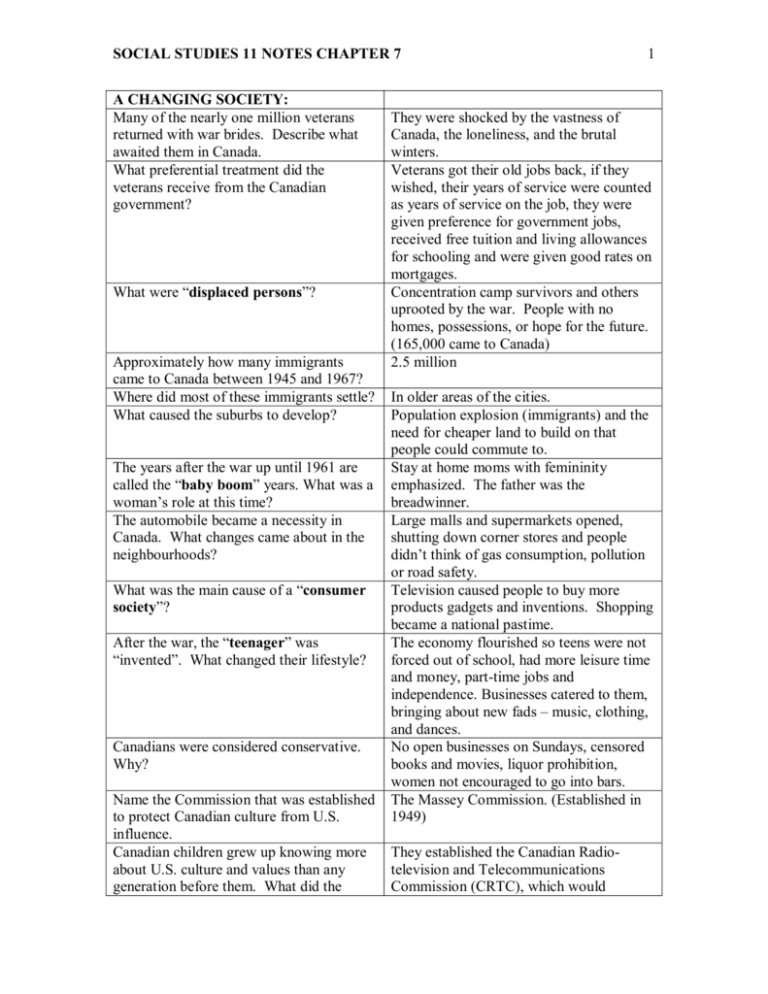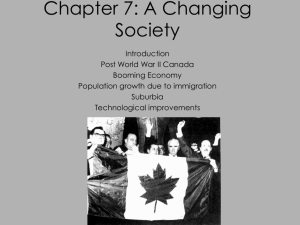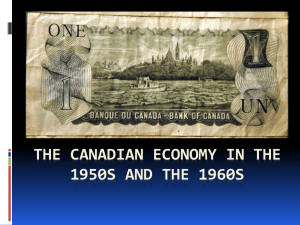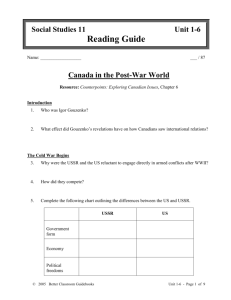SOCIAL STUDIES 11 NOTES CHAPTER 7 1 A CHANGING
advertisement

SOCIAL STUDIES 11 NOTES CHAPTER 7 A CHANGING SOCIETY: Many of the nearly one million veterans returned with war brides. Describe what awaited them in Canada. What preferential treatment did the veterans receive from the Canadian government? What were “displaced persons”? 1 They were shocked by the vastness of Canada, the loneliness, and the brutal winters. Veterans got their old jobs back, if they wished, their years of service were counted as years of service on the job, they were given preference for government jobs, received free tuition and living allowances for schooling and were given good rates on mortgages. Concentration camp survivors and others uprooted by the war. People with no homes, possessions, or hope for the future. (165,000 came to Canada) 2.5 million Approximately how many immigrants came to Canada between 1945 and 1967? Where did most of these immigrants settle? In older areas of the cities. What caused the suburbs to develop? Population explosion (immigrants) and the need for cheaper land to build on that people could commute to. The years after the war up until 1961 are Stay at home moms with femininity called the “baby boom” years. What was a emphasized. The father was the woman’s role at this time? breadwinner. The automobile became a necessity in Large malls and supermarkets opened, Canada. What changes came about in the shutting down corner stores and people neighbourhoods? didn’t think of gas consumption, pollution or road safety. What was the main cause of a “consumer Television caused people to buy more society”? products gadgets and inventions. Shopping became a national pastime. After the war, the “teenager” was The economy flourished so teens were not “invented”. What changed their lifestyle? forced out of school, had more leisure time and money, part­time jobs and independence. Businesses catered to them, bringing about new fads – music, clothing, and dances. Canadians were considered conservative. No open businesses on Sundays, censored Why? books and movies, liquor prohibition, women not encouraged to go into bars. Name the Commission that was established The Massey Commission. (Established in to protect Canadian culture from U.S. 1949) influence. Canadian children grew up knowing more They established the Canadian Radio­ about U.S. culture and values than any television and Telecommunications generation before them. What did the Commission (CRTC), which would SOCIAL STUDIES 11 NOTES CHAPTER 7 Canadian government do about this? What does the term “baby boom echo” mean? How did Prime Minister Mackenzie King try to handle the transition to a peacetime economy? How did the government maintain unemployment insurance and family allowances? What were “boom towns”? Name three of the “megaprojects” that changed the face of the Canadian landscape. There has always been concern about Canada losing control of its economy to the U.S. What has brought about a new economic relationship? The booming economy allowed the trade unions to bring about many changes. Name these benefits. Which groups did not share the prosperity of the times? Who was Joey Smallwood and what changes did he bring to Canada? When Mackenzie King retired, who became Canada’s Prime Minister? For the next decade, Canada had two men dominate politics as leader of the opposition and Prime Minister. Name them. What changes to human rights did Diefenbaker make? What new features of modern Canada did Lester Pearson introduce? What social benefits did Mackenzie King introduce? What social benefits did Lester Pearson’s 2 regulate the amount of foreign material broadcast. The children of baby boomers, born between 1981 and 1996. Government incentives, tax breaks, Crown corporations auctioned to private companies at low prices. The federal government received taxation powers while the provinces received grants, “equalization” or” transfer” payments. (transfer to the poorer provinces some of the taxes collected in the richer provinces.) Towns that developed out of the wilderness where new mines and oil wells were. The Trans­Canada Highway, The St. Lawrence Seaway and the Trans­Canada Pipeline. The Free Trade Agreement. Higher wages, a five­day, forty hour work week and paid vacations. Women, poor immigrants and First Nations people Joey Smallwood convinced Newfoundlanders to vote to join Canada in 1949. Louis St. Laurent. Lester Pearson and John Diefenbaker. He gave the right to vote to status Indians, introduced the Canadian Bill of Rights and included women and natives in Canadian politics. Our Canadian flag, easier divorce laws, an abolition of capital punishment and improvements of Canada’s social welfare system. Unemployment insurance in 1940 and family allowance (baby bonus) in 1944. The Canada Pension Plan, the Canada SOCIAL STUDIES 11 NOTES CHAPTER 7 government introduce? 3 Assistance Plan (to help provinces assist needy people) and Medicare. What was the “Medical Care Act”? Federal and Provincial governments would share the cost of medical care by doctors and hospitals for all Canadians, with funding coming from taxes. Who was T.C. “Tommy” Douglas and He was Premier of Saskatchewan and what is he known for? introduced a complete medicare program. Who was Pearson’s successor? Pierre Elliot Trudeau. What did Trudeau mean when he wanted to Government had a duty to protect the rights build a “just society”? and freedoms of people and to foster social and economic well­being. He also believed in individual freedom and that governments should not interfere with personal liberties. What is a “youthquake”? The baby boom youth (over ½ of the population of N. America was under 25) created a powerful youth culture of protest.(hippies, the Beatles and rock and roll groups) How did politicians appeal to the young By lowering the federal voting age to 18, people? providing employment and activities for youth and by lowering the legal drinking age to 18 in most provinces. What issues did feminists press for from The right to work outside the home, day the Royal Commission on the Status of care services, maternity leave, and help to Women in 1967? overcome discrimination against women in society. What measures were implemented to limit Laws to prove company plants and projects pollution in the environment? would not harm their immediate environment, recycling in homes and industry, more fuel­efficient cars and Greenpeace (designed to draw attention to environmental issues) was established. What was the most important factor in the A 400% increase in the cost of oil and gas inflation that hit Canada in the 1970’s? prices causing prices to rise and the dollar to fall in value. What changes did the rising inflation cause Higher prices, the need for women to enter in the average Canadian household? the workforce and the highest unemployment levels since the 1930’s. Explain regional disparity. The economic gap between the poorer and more prosperous regions of Canada. “Western alienation” has long been a People of the west have long believed that problem in Canada. Explain this term and many of Ottawa’s policies favour central give an example. Canada at the expense of the West. In the 1970’s, the federal government froze the price of domestic oil and gas, infuriating SOCIAL STUDIES 11 NOTES CHAPTER 7 4 Albertans, who felt that they had the right to charge world prices. What was the aim of the NEP (National To reduce consumption of oil, to protect Energy Program)? Canadians from rising oil prices and to make Canada self­sufficient in oil. The Canadian government was operating at The amount of money being spent was far a deficit due to the cost of social services greater than revenues (money taken in, and moves to protect economic well­being. especially through taxes). What does “deficit” mean? Who succeeded Trudeau as Canada’s Brian Mulroney and the Progressive Prime Minister in 1984? Conservatives (Trudeau ­1967­1984) How did Brian Mulroney plan to cut the By cutting social programs, cutting the rate debt? of taxes and using the Free Trade Agreement with the U.S. to cause businesses to thrive. Did his plan work? No. Canada was hit by recession in1990, businesses failed, workers lost their jobs, and more welfare and unemployment was needed. The debt was increased and taxes went up. Jean Chrétien and the Liberals came to By injecting more money into the economy power in 1993. How did they plan to solve to create jobs and workers would then the national debt of $446 billion? spend more and boost the economy. What happened to stop this policy? Interest rates shot up, causing Paul Martin (Finance Minister) to cut federal spending on education, healthcare and welfare. Subsidies to businesses were removed and the deficit grew smaller. How did Canadians “pay” for the Tuition fees were raised, the health care government achieving its aim? system suffered, rising numbers of homeless and thousands of Canadian children were living in poverty. Canada had entered the “information age”. Computers, world travel, satellite Explain this term. broadcasting, cheap long­distance calling and the internet all brought about a new economy. SOCIAL STUDIES 11 NOTES CHAPTER 7 5 SOCIAL STUDIES 11 NOTES CHAPTER 7 6










